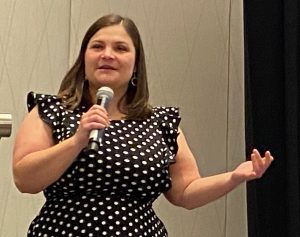Trauma can “fracture” the stories that enable individuals and communities to make sense of life, but preaching, ministry and worship can help trauma victims discover resilience and recover emotionally, Kimberly Wagner told participants at the Cooperative Baptist Fellowship’s General Assembly in Atlanta June 28.
CBF offered a “leadership luncheon” session on trauma in response to a 2020 survey of the organization’s constituents. They identified “dealing with trauma” as one of the key needs faced by congregations, CBF Executive Coordinator Paul Baxley said.

Kimberly Wagner
Wagner, assistant professor of preaching at Princeton Theological Seminary, is the author of Fractured Ground: Preaching in the Wake of Mass Trauma, which describes her findings from research into how preaching intersects trauma.
“Trauma is a blow or wounding of the mind, body and spirit/self that occurs when a destructive experience or event exceeds a person’s or a community’s resources to process or assimilate the experience into preconceived frameworks of understanding,” Wagner explained.
People tell stories — about themselves, their communities, God and other ideas — to help make sense of life, but traumatic experiences exist outside those stories and confound the ability to make sense of them, she added, noting a distinctive feature of trauma is disorientation.
Trauma creates crises of time and of coherence, she said. A crisis of time exists when trauma and/or a traumatic experience becomes “an eternal present” and distorts one’s connection between the past, present and future. And a crisis of coherence occurs when one’s world and story no longer feel comprehensive, safe or helpful, and meaningful.
Together, a crisis of time and a crisis of coherence produce “narrative fracture,” Wagner said, noting she chose the word “fracture” intentionally. The stories or narratives are not obliterated, decimated or crushed, because “people are resilient” and even fractured narratives can be put back together.
“When they experience trauma, people come to pastors with baskets of broken pieces (of their narratives) and ask, ‘What do I do with this?’”
“When they experience trauma, people come to pastors with baskets of broken pieces (of their narratives) and ask, ‘What do I do with this?’” she explained, urging pastors to “name, honor and bless” those broken pieces.
Ministers who respond to communal trauma must understand it manifests differently than individual trauma and is not equal to the sum of the individual trauma experienced by members of the community.
For example, crisis of time experienced in community “disorients communal activity and relationships and becomes a pervasive shadow over the community that revisits at unexpected times, places and ways,” she said. “This can be a sticking point in the story and identity of the community.”
Similarly, crisis of coherence in community renders “stories told in community no longer … comprehensible, helpful or meaningful,” she added. “Foundational stories no longer serve in the same way to help shape or secure communal identity. … The values of community are thrown into question, and communities no longer feel valuable in the same way.”
Collective trauma also results in “separating forces” that pull communities apart, Wagner said. Communities fracture apart along the fault lines of individuals’ proximity to the traumatizing event.
Often, it’s easier to fight about a side issue that is only tangentially related to the trauma than to actually face and deal with the trauma itself.
They also fracture along the fault lines of unresolved or unaddressed conflict, she said. Often, it’s easier to fight about a side issue that is only tangentially related to the trauma than to actually face and deal with the trauma itself.
“How might preaching, ministry and worship faithfully respond to these traumatic realities?” she asked. Those aspects of congregational life together:
- “Offer language” for dealing with trauma.
- “Create space for honest reflection.”
- “Model faithful traumatic response.”
- “Facilitate communal connection, support and empathy.”
- “Center us in the patterns of our life together and stories of our faith.”
- “Remind us we are not alone.”
To help people respond effectively to trauma, ministers must preach and teach in the “eschatological tension” created by the traumatic event or events, Wagner said. This includes a sense of brokenness, death and loss on one extreme and an expectation of hope, resurrection and redemption on the other.
And ministers must resist the temptation to collapse the tension between the two extremes, she urged. Moving too quickly from brokenness to hope is inauthentic and implies people are “beyond the love of God” if they do not feel hope as soon as others feel it.
Initially, ministers identify with how traumatized people lean toward the brokenness, but they hold out a thread of hope. Later, they can preach toward hope and resurrection, “and still hold onto the thread of brokenness, because without brokenness, we don’t need hope,” she said.
Ministers also should not promise more than can be delivered, Wagner stressed. “Life never will be as it was before” the traumatic event. But people dealing with trauma can cultivate resiliency and move toward recovery.


